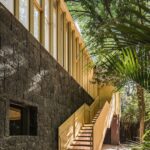Educational Area and Visitor Service Center of Chapultepec Zoo Harmonizing with Nature

Project Overview
The “Educational Area and Visitor Service Center” project, developed by TEAM730, is situated along the north face of the main access road of the Alfonso L. Herrera Chapultepec Zoo, within the 1st Section of the Chapultepec Forest in Mexico City. It forms part of a larger initiative aimed at enhancing the zoo’s educational and cultural offerings.
Design Philosophy: Integration and Sustainability
The design approach prioritized minimizing the environmental impact of the intervention while seamlessly integrating with the surrounding landscape. Existing plant species were preserved and incorporated into the architectural experience, with a focus on maximizing water permeability to the subsoil. The goal was to create a structure that not only harmonizes with its natural surroundings but also adds value to the underutilized property.
 Architectural Concept: Blurring Boundaries
Architectural Concept: Blurring Boundaries
The design is based on a regular quadrangular prism, serving as the fundamental unit of modulation. Spread across the terrain, the new construction aims to blur the boundaries between architecture and nature. A total of 56 modules house various amenities, including walkways, stairs, an open-air forum, multipurpose rooms, visitor service areas, and more. Elevated covered spaces minimize environmental impact and maximize rainwater catchment.
 Spatial Articulation: Light and Shadow Play
Spatial Articulation: Light and Shadow Play
Through the strategic arrangement of empty modules, striated quadrants, and a mix of solid and transparent surfaces, the design creates a dynamic interplay of light and shadow. Interior and exterior spaces are seamlessly integrated, with vegetation further enhancing the sensory experience. The result is a series of interconnected spaces that engage with geometry and nature in harmony.
 Adaptive Reuse and Transparency
Adaptive Reuse and Transparency
Existing structures were repurposed to conserve architectural quality while strategically intervening to meet modern needs. Additionally, a new volume, characterized by its lightness and transparency, serves as a contemporary addition that complements the existing architecture. This new element engages in a dialogue with the stone base and surrounding landscape, further enriching the architectural narrative.
 In conclusion, the Educational Area and Visitor Service Center of Chapultepec Zoo embodies a holistic approach to design, prioritizing sustainability, integration with nature, and the creation of engaging educational spaces within a unique cultural context.
In conclusion, the Educational Area and Visitor Service Center of Chapultepec Zoo embodies a holistic approach to design, prioritizing sustainability, integration with nature, and the creation of engaging educational spaces within a unique cultural context.


























